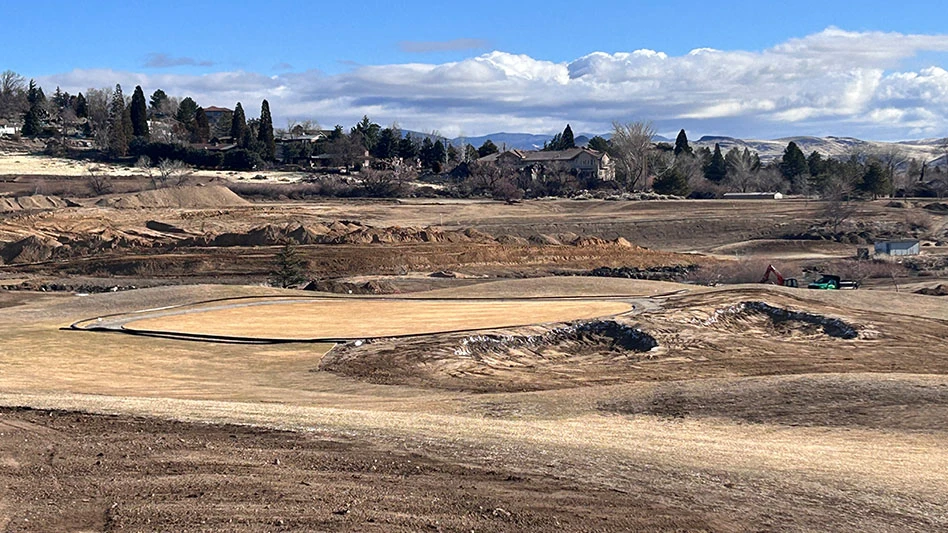Overall, it looks like the business of golf will experience a slight improvement this year compared with last year. But many superintendents will still have to do more work with less money, or at least the same amount of money, because many golf course maintenance budgets won’t increase that much. In a nutshell, business is steady.
|
|
“In ’04, we largely righted the ship,” says Steve Mona, c.e.o. of the Golf Course Superintendents Association of America. “In ’01, we began to dip, and we had three pretty tough years. In ’04, there were signs of optimism, but no signs of an upswing.”
The industry is trying to get out of a downturn. There had been a 2-percent to 4-percent decline of rounds played during 2002 and 2003, but there was an uptick of rounds played in 2004 largely because corporate profits have increased, causing corporate golf and corporate outings to increase, according to Mike Hughes, executive director of the National Golf Course Owners Association.
“There are larger and more fields of golfing groups at courses and clubs, and food-and-beverage sales have increased,” Hughes says. “It all stems from the improved economy. That will pretty much be the same for 2005.”
Luke Stavros, director of golf at the Coeur d’Alene (Idaho) Resort Golf Course, says rounds at the course increased 3.5 percent in 2004, which is better than the forecasted national average of 0.6 percent according to NGF.
“We’re starting to see a positive increase in travel and spending,” Stavros says, adding that most of the golfers that play the course come from the Western part of the country. “We feel good because we’re better than the national average, and we attribute that to enhancing our overall product.”
Even though certain sectors of the golf industry have settled, golf still isn’t stable, according to Mona.
“’04 was challenging,” he says. “In some cases it was better, but it was marginally better than ’03.”
Mona says most of the traditional, well-established private clubs that have long waiting lists managed to do fairly well in ’04, even though members might not have been spending as much and clubs’ waiting lists might not have been as long.
Generally, at the middle-of-the-road private clubs in the smaller metro areas, members are staying home and using their club more often because they’re not traveling as much due to the economy, Mona says.
The public courses generally have been the toughest-hit area of the golf course industry, according to Mona.
“The middle to high-end facilities have a problem because they aren’t private and aren’t charging or collecting fees and monthly dues,” he says.
However, the least expensive public courses continue to do well because they are inexpensive and attract people who can afford to play regularly, Mona says.
“There will be more optimism in ’05,” he says. “The stock market, which has had a wild ride, is doing better, people have more confidence and unemployment is steady. But there’s a false sense of optimism that things are going to be marginally better just because the calendar turns. I’m fairly cautious.”
For Hughes, course performance isn’t a geographic issue, it’s a market issue. He says private clubs are probably performing a bit better than public courses.
“If you’re in the middle of a market, you have probably suffered more than if your course is at the top of the market,” he says.
Tim Perez, director of golf courses and grounds at Fiddlesticks Country Club in Fort Myers, Fla., estimates the bottom of the downturn was about 18 months ago.
“One of the tough things about this business is that it’s a huge collaboration of factors that make the game expensive,” Perez says. “The greatest hindrance to the business and the game is the cost to play. There is so much emphasis on playing-surface purity. Today, we are managing every square inch of the course. We’ve lost the game somehow, someway. We are our own worst enemy. The average player will never be able to enjoy the perfect playing surface that he sees on television. I miss the challenge of the old game of golf.”
Belt tightening
In these lean financial times, resourceful superintendents find ways to provide good course conditions even though budgets have tightened. Mona says efficiencies that have been created will continue even if business improves.
|
|
However, Hughes says that during the downturn owners were belt tightening and everybody was learning how to get more out of less, so there will be an immediate profit increase if the industry experiences a quick turnaround.
Improving the product
Despite the tight budgets, owners have been improving their products during the past five years and will continue to do so, according to Hughes. Because of the additional supply to the market during the past 10 years, the amount of modest renovations has increased.
|
|
During the downtimes, most facilities will make cutbacks and reduce prices, but Hagadone Hospitality Co., owner of the Coeur d’Alene Resort Golf Course, is doing the opposite and is spending money to renovate.
“In 2003, we lengthened the course 500 yards and added more than 12 new tee boxes so we have five tee boxes a hole, added 21 new sand bunkers and planted 250 pine trees that are 12- to 16-feet high,” Stavros says. “In 2004, we reconstructed one green and its surround and added a subair system to it.”
Additional renovations to the course include new green surrounds on another hole, and new contouring and sod on the three other holes. Also, the irrigating system and landscaping are being upgraded.
In Florida, the main course at Fiddlesticks is being rebuilt.
“We’re upgrading the irrigation, constructing USGA-specified greens, as well as upgrading the staff and equipment,” Perez says. “We have all the right people involved. We have a good golf course construction superintendent.
“We’ll be reduced to one golf course this year,” he adds. “It will be tough if you are a player.”
The Fiddlesticks renovation is scheduled to be completed by Nov. 1.
What to expect
Some superintendents are upbeat about 2005 and believe it will be a better year businesswise than 2004. Stavros says 60 percent of the golfers at his resort come from the Pacific Northwest, 20 percent from the Western part of the United States and another 20 percent from elsewhere in the country.
“We’re starting to see an increase of business outside the northwest,” he says.
The Coeur d’Alene Resort Golf Course also is doing well enough to raise greens fees. Last year fees were $210, and this year they will be $225 for a day guest fee.
The golf season at the resort is from April 15 to mid-October, and Stavros predicts 2005 will be the best year since 2000, which is a result of group business and corporate spending increases, as well as the added value Stavros says the course provides.
Rich Eichner, superintendent at the 18-hole Discovery Bay Golf and Country Club in Bryon, Calif., says his budget for 2005 increased slightly partly because of cost-of-living increases. Fuel prices and energy costs have increased, too.
“Fuel prices are a crapshoot because they have been all over the map,” Eichner says. “Gas went up 40 cents a gallon, then dropped 30 cents a gallon. Even the fuel suppliers can’t predict the trends.”
Eichner says California state law requires him to use oxygenated fuel, which is causing problems. He can’t get fuel from outside the state because California is the only state that requires oxygenated fuel by law. This makes fuel more expensive. Additionally, in Northern California fertilizer costs will increase, but herbicide and fungicide costs will decrease and might cancel each other out, Eichner says.
Despite an increase in operating costs, Eichner says 2005 will be a good year because of the improving economy and additional members the club expects to gain.
“For 2004 and 2005, there is an upswing in the golf industry in northern California,” he says.
But despite the optimism, there still is concern in certain areas of the industry. Mona says some superintendents in the North are trying to hire H2B workers but can’t because there are none left. This is because people in the North prepare for their season later than those in the South.
“That is going to create problems,” he says. “We have members that will be negatively impacted.
With all the emphasis on tighter budgets and hope that this year will be better than last, the GCSAA is encouraging superintendents to view themselves as part of a formula of success at their club.
“Our members are increasingly saying, ‘I’m not only responsible for the course but also the success of the club,’” Mona says. “We are encouraging them to do things such as help boost play and help increase revenue at their clubs. Superintendents are being encouraged to be more integrally involved in the business of golf.
“Golf is a very different business than it was 25 years ago,” he adds. “It’s different than it was 11 years ago, and a lot of it has to do with the changing world.”
But it doesn’t start or stop with superintendents. More and more owners are getting involved with growing the game, according to Hughes.
“People haven’t fled the game in great numbers, but people are playing fewer and fewer rounds,” he says. “Owners are producing programs to get more people out and play more often. These grassroots efforts are needed for a turnaround. There is no quick fix.” GCN
John Walsh is the editor of Golf Course News. He can be reached at jwalsh@gie.net.
|
|

Explore the February 2005 Issue
Check out more from this issue and find your next story to read.
Latest from Golf Course Industry
- The Cabot Collection announces move into course management
- Carolinas GCSA raises nearly $300,000 for research
- Advanced Turf Solutions’ Scott Lund expands role
- South Carolina’s Tidewater Golf Club completes renovation project
- SePRO to host webinar on plant growth regulators
- Turfco introduces riding applicator
- From the publisher’s pen: The golf guilt trip
- Bob Farren lands Carolinas GCSA highest honor















